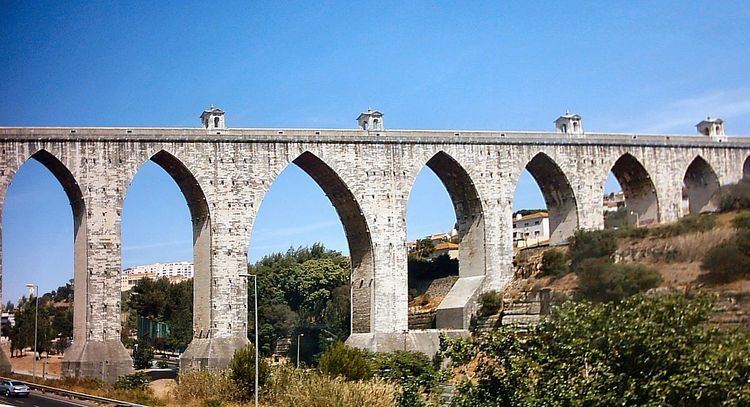Construction started 1713 Phone +351 21 810 0215 | Opened 1748 Bridge type Aqueduct | |
 | ||
Similar Museu da Água, Estrela Basilica, São Jorge Castle, Jerónimos Monastery, Palace of the Marquise | ||
A guas livres aqueduct lisbon portugal
The Águas Livres Aqueduct (Portuguese: Aqueduto das Águas Livres, [ɐkɨˈdutu dɐʃ ˈaɡwɐʃ ˈlivɾɨʃ], "Aqueduct of the Free Waters") is a historic aqueduct in the city of Lisbon, Portugal. It is one of the most remarkable examples of 18th-century Portuguese engineering. The main course of the aqueduct covers 18 km, but the whole network of canals extends through nearly 58 km.
Contents
- A guas livres aqueduct lisbon portugal
- Walking in guas livres aqueduct lisbon
- History
- Me dgua
- References
The city of Lisbon has always suffered from the lack of drinking water, and King John V decided to build an aqueduct to bring water from sources in the parish of Caneças, in the modern municipality of Odivelas. The project was paid for by a special sales tax on beef, olive oil, wine, and other products.
Walking in guas livres aqueduct lisbon
History
Construction started in 1731 under the direction of Italian architect Antonio Canevari, replaced in 1732 by a group of Portuguese architects and engineers, including Manuel da Maia, Azevedo Fortes and José da Silva Pais. Between 1733 and 1736, the project was directed by Manuel da Maia, who in turn was replaced by Custódio Vieira, who would remain at the head of the project until around 1747.
Custódio Vieira conceived the centerpiece of the aqueduct, the arches over the Alcantara valley, completed in 1744. A total of 35 arches cross the valley, covering 941 m. The tallest arches reach a height of 65 m, and many are pointed, reminiscent of arches in Gothic style. It is considered a masterpiece of engineering in the Baroque period.
In 1748, although the project was still unfinished, the aqueduct finally started to bring water to the city of Lisbon, a fact celebrated in a commemorative arch built in the Amoreiras neighbourhood. From this period on, construction was overseen by other architects, including Carlos Mardel of Hungary and others. During the reigns of José I and Maria I, the network of canals and fountains was greatly enlarged.
At November 1st, 1755, occurred the 1755 Lisbon earthquake but the brand new aqueduct managed to remain intact!
It is possible to visit and cross, through Museu da água (water museum)
Mãe d'Água
The Mãe d'Água (Mother of the Water) reservoir of the Amoreiras, the largest of the water reservoirs, was finished in 1834. This reservoir, with a capacity of 5,500 m³ of water, was designed by Carlos Mardel. It is now deactivated and can be visited as part of the Museu da Água (Water Museum).
